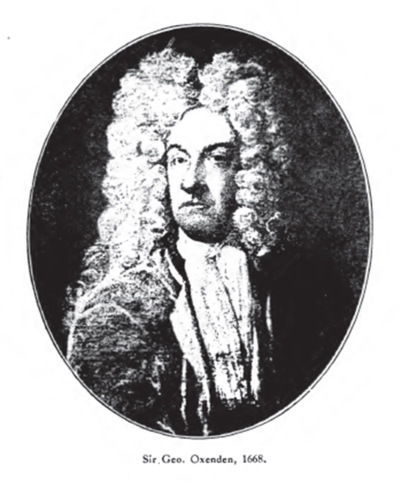Difference between revisions of "MRP: Sir George Oxenden"
| Line 7: | Line 7: | ||
-->([[MRP: 9th April 1663, Letter from Robert Raworth to Sir GO| Robert Raworth to Sir George Oxenden, April 9th, 1663]])<-- | -->([[MRP: 9th April 1663, Letter from Robert Raworth to Sir GO| Robert Raworth to Sir George Oxenden, April 9th, 1663]])<-- | ||
| + | |||
| + | '''Sir George Oxenden, engraving, 1668''' | ||
| + | |||
| + | [[File:Sir George Oxenden Engraving 1668_copy2.png|thumbnail|400px|none]] | ||
As president of the English East India company in Surat between 1663 and 1669, Sir George Oxenden left a private correspondence with his sister, [[MRP: Elizabeth Dallison|Elizabeth Dallison]], and with other kin, close friends, commercial partners. The correspondence, now in the British Library, provides a starting point from which to explore their lives. Bound in still bright red Indian leather, the volumes are the work of Oxenden’s copyists, his factory writers, rather than autograph manuscripts. The communication is largely one way, with Oxenden’s own voice often to be inferred from the tone and substance of his correspondents. | As president of the English East India company in Surat between 1663 and 1669, Sir George Oxenden left a private correspondence with his sister, [[MRP: Elizabeth Dallison|Elizabeth Dallison]], and with other kin, close friends, commercial partners. The correspondence, now in the British Library, provides a starting point from which to explore their lives. Bound in still bright red Indian leather, the volumes are the work of Oxenden’s copyists, his factory writers, rather than autograph manuscripts. The communication is largely one way, with Oxenden’s own voice often to be inferred from the tone and substance of his correspondents. | ||
| Line 12: | Line 16: | ||
A careful reading of the correspondence reveals the existence of two connected joint stock companies formed in in the decade prior to Oxenden’s presidency by Sir George Oxenden and five former colleagues from Surat. Two slightly divergent lists of subscribers to the two ventures were subsequently discovered by this author in the National Archives in Chancery papers related to the ventures. In 1655 the English East India company was in disarray, its monopoly had expired, and the eastern markets were up for grabs. Yet, the ventures have little visibility in the historiography, and are the subject of only a brief footnote by Sir William Foster. | A careful reading of the correspondence reveals the existence of two connected joint stock companies formed in in the decade prior to Oxenden’s presidency by Sir George Oxenden and five former colleagues from Surat. Two slightly divergent lists of subscribers to the two ventures were subsequently discovered by this author in the National Archives in Chancery papers related to the ventures. In 1655 the English East India company was in disarray, its monopoly had expired, and the eastern markets were up for grabs. Yet, the ventures have little visibility in the historiography, and are the subject of only a brief footnote by Sir William Foster. | ||
| − | |||
| − | |||
---- | ---- | ||
==Sources== | ==Sources== | ||
Revision as of 10:06, October 7, 2011
Sir George Oxenden
-->"you haveing for y:e tyme past truely made your life a kinde of á pilgrimage, br
you have seene many of y:e great wonders of y:e Great God, Ocularly, w:ch wee br
have onely by Contemplation, & in y.t I (that have never beene out of my br
native Countrey) have taken great pleasur"<--
-->( Robert Raworth to Sir George Oxenden, April 9th, 1663)<--
Sir George Oxenden, engraving, 1668
As president of the English East India company in Surat between 1663 and 1669, Sir George Oxenden left a private correspondence with his sister, Elizabeth Dallison, and with other kin, close friends, commercial partners. The correspondence, now in the British Library, provides a starting point from which to explore their lives. Bound in still bright red Indian leather, the volumes are the work of Oxenden’s copyists, his factory writers, rather than autograph manuscripts. The communication is largely one way, with Oxenden’s own voice often to be inferred from the tone and substance of his correspondents.
A careful reading of the correspondence reveals the existence of two connected joint stock companies formed in in the decade prior to Oxenden’s presidency by Sir George Oxenden and five former colleagues from Surat. Two slightly divergent lists of subscribers to the two ventures were subsequently discovered by this author in the National Archives in Chancery papers related to the ventures. In 1655 the English East India company was in disarray, its monopoly had expired, and the eastern markets were up for grabs. Yet, the ventures have little visibility in the historiography, and are the subject of only a brief footnote by Sir William Foster.
Sources
Primary
C10/109/102 (1663); C10/82/2 (1664)
IOR/H/MISC/32 Various letters relating to the Williams Venture
Letter from Robert Raworth to Sir George Oxenden, Grays Inn, 9th April 1663, ff. 106-107
The Oxenden papers, Vols. XIII-XVIII, Add. MSS. 40708-40713
Secondary
William Foster (ed.), XXXX, citing Home Miscellaneous Vol. 26, 10 June 165[8?] (folio 5)
Images
'Sir George Oxenden, 1668', unnumbered plate, between pp. 40 & 41, in Cecil L. Burns, Catalogue of the Collection of Maps, Prints and Photographs of the Island & City of Bombay, Victoria & Albert Museum (Bombay, 1918). No artist, technical details, nor provenance given.
Image credits
'Sir George Oxenden, 1668', unnumbered plate, between pp. 40 & 41, in Cecil L. Burns, Catalogue of the Collection of Maps, Prints and Photographs of the Island & City of Bombay, Victoria & Albert Museum (Bombay, 1918). Book and image are out of copyright.
